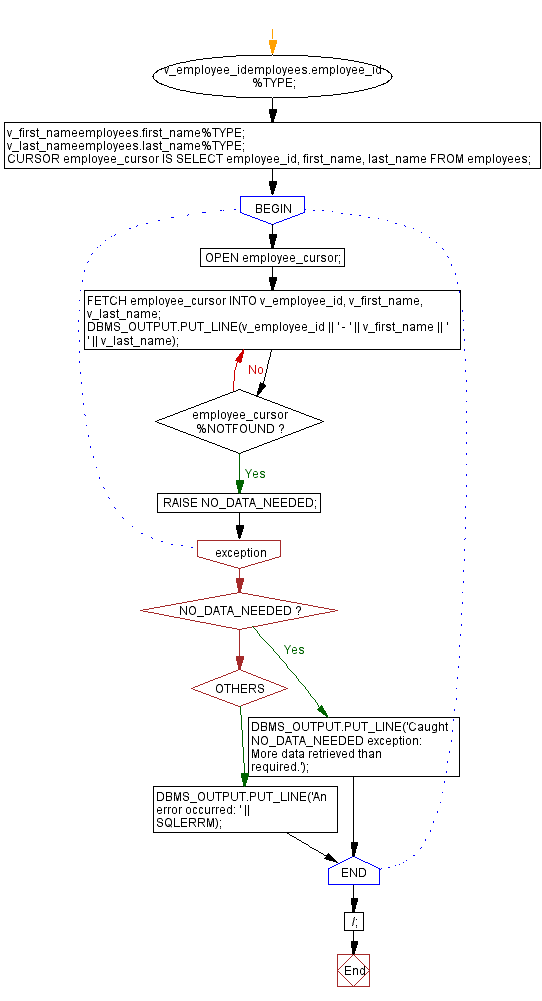Handling NO_DATA_NEEDED exception in PL/SQL
PL/SQL Exception Handling: Exercise-16 with Solution
Handle the NO_DATA_NEEDED exception when a query retrieves more data than required.
Sample Solution:
Table: employees
employee_id integer first_name varchar(25) last_name varchar(25) email archar(25) phone_number varchar(15) hire_date date job_id varchar(25) salary integer commission_pct decimal(5,2) manager_id integer department_id integer
PL/SQL Code:
DECLARE
v_employee_idemployees.employee_id%TYPE;
v_first_nameemployees.first_name%TYPE;
v_last_nameemployees.last_name%TYPE;
CURSOR employee_cursor IS
SELECT employee_id, first_name, last_name
FROM employees;
BEGIN
OPEN employee_cursor;
LOOP
FETCH employee_cursor INTO v_employee_id, v_first_name, v_last_name;
DBMS_OUTPUT.PUT_LINE(v_employee_id || ' - ' || v_first_name || ' ' || v_last_name);
IF employee_cursor%NOTFOUND THEN
RAISE NO_DATA_NEEDED;
END IF;
END LOOP;
EXCEPTION
WHEN NO_DATA_NEEDED THEN
DBMS_OUTPUT.PUT_LINE('Caught NO_DATA_NEEDED exception: More data retrieved than required.');
WHEN OTHERS THEN
DBMS_OUTPUT.PUT_LINE('An error occurred: ' || SQLERRM);
END;
/;
Sample Output:
………. ………. 201 - Michael Hartstein 202 - Pat Fay 203 - Susan Mavris 204 - Hermann Baer 205 - Shelley Higgins 206 - William Gietz 206 - William Gietz Caught NO_DATA_NEEDED exception: More data retrieved than required.
Explanation:
The said code in Oracle's PL/SQL that demonstrates how to handle the NO_DATA_NEEDED exception in the context of a cursor, specifically when more data is retrieved than necessary.
The three variables v_employee_id, v_first_name, and v_last_name of type employee_id, first_name, and last_name respectively in the employees table are declared and also declares a cursor employee_cursor that selects the employee_id, first_name, and last_name from the employees table.
Inside the block, the cursor opens and enters a loop, and each iteration of the loop, it fetches data from the cursor into the declared variables and outputs the employee ID, first name, and last name using DBMS_OUTPUT.PUT_LINE.
If the cursor reaches the end of the result set and no more data is available, in that cases, the code raises the NO_DATA_NEEDED exception, and the exception handling section, outputs a message indicating that more data was retrieved than required.
Flowchart:

Go to:
PREV : Handling ACCESS_INTO_NULL exception in PL/SQL.
Have another way to solve this solution? Contribute your code (and comments) through Disqus.
What is the difficulty level of this exercise?
